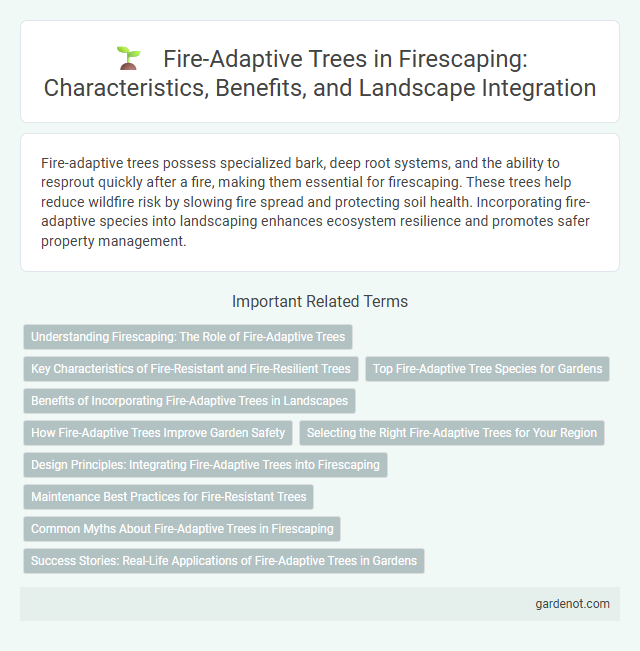Fire-adaptive trees possess specialized bark, deep root systems, and the ability to resprout quickly after a fire, making them essential for firescaping. These trees help reduce wildfire risk by slowing fire spread and protecting soil health. Incorporating fire-adaptive species into landscaping enhances ecosystem resilience and promotes safer property management.
Understanding Firescaping: The Role of Fire-Adaptive Trees
Fire-adaptive trees play a crucial role in firescaping by possessing natural traits such as thick bark, self-pruning branches, and high moisture content that enable them to survive and recover from wildfires. These species, including ponderosa pine and manzanita, help create defensible spaces and reduce fire intensity by slowing fire spread and minimizing available fuel. Incorporating fire-adaptive trees into landscape design enhances ecosystem resilience while protecting property from catastrophic fire damage.
Key Characteristics of Fire-Resistant and Fire-Resilient Trees
Fire-adaptive trees possess thick, insulating bark and self-pruning branches that reduce combustible materials, enhancing their fire resistance. Their ability to resprout quickly after fire damage demonstrates remarkable fire resilience, enabling rapid recovery and sustained growth. Species such as the Ponderosa pine and California black oak exemplify these key characteristics, making them vital for effective firescaping strategies.
Top Fire-Adaptive Tree Species for Gardens
Top fire-adaptive tree species for gardens include the California Sycamore (Platanus racemosa), which exhibits thick bark and rapid resprouting after fire. The Manzanita (Arctostaphylos spp.) features fire-resistant foliage and seeds that require heat exposure to germinate, promoting forest regeneration. Another key species is the Canyon Live Oak (Quercus chrysolepis), known for its deep root system and ability to survive low to moderate fires, making it ideal for fire-adapted landscapes.
Benefits of Incorporating Fire-Adaptive Trees in Landscapes
Incorporating fire-adaptive trees in landscapes enhances wildfire resilience by reducing fuel loads and slowing fire spread, which protects property and natural habitats. These species possess thick bark, self-pruning branches, and high moisture content, features that improve their survival and promote rapid ecosystem recovery after fires. Fire-adaptive trees also support biodiversity by providing habitat for wildlife and maintaining soil stability, contributing to long-term landscape sustainability.
How Fire-Adaptive Trees Improve Garden Safety
Fire-adaptive trees improve garden safety by naturally resisting ignition and slowing fire spread through thick bark, moisture-rich leaves, and strategic branch placement. Species such as Quercus agrifolia (coast live oak) and Pinus attenuata (knobcone pine) promote landscape resilience by reducing fuel load and enhancing firebreaks. Incorporating these trees in fire-prone areas helps create defensible space, minimizing property damage and protecting ecosystems during wildfires.
Selecting the Right Fire-Adaptive Trees for Your Region
Selecting fire-adaptive trees native to your specific region enhances landscape resilience by naturally reducing wildfire risk and promoting ecosystem recovery. Species such as the blackjack oak in the southern U.S. or the sugar pine in the Pacific Northwest possess thick bark and deep root systems that allow them to survive low-intensity fires. Incorporating these regionally appropriate fire-adaptive trees into your firescape supports both fire mitigation and biodiversity conservation.
Design Principles: Integrating Fire-Adaptive Trees into Firescaping
Fire-adaptive trees possess traits such as thick bark, self-pruning branches, and fire-resistant foliage that enhance landscape resilience to wildfires. Designing firescaping with these trees involves strategic placement to create natural firebreaks and reduce fuel continuity while maintaining ecosystem health. Incorporating fire-adaptive species like quercus agrifolia or pinus ponderosa supports long-term land management by minimizing fire damage and promoting rapid recovery.
Maintenance Best Practices for Fire-Resistant Trees
Fire-adaptive trees such as oak, manzanita, and madrone require regular maintenance to enhance their fire-resistant properties. Pruning dead or overgrown branches, removing leaf litter, and maintaining adequate spacing between plants help reduce fuel loads and improve tree resilience during wildfires. Consistent irrigation during dry periods supports tree health, promoting thick bark and moisture retention that contribute to fire resistance.
Common Myths About Fire-Adaptive Trees in Firescaping
Fire-adaptive trees, such as the Western Redbud and Manzanita, possess traits like thick bark and deep-root systems that help them survive wildfires, contradicting the myth that all trees easily catch fire and perish during fires. Another common misconception is that fire-adaptive trees promote fire spread, while in reality, their ability to resprout and reduce surface fuels can help moderate fire intensity and promote ecosystem recovery. Understanding these fire-resilient characteristics is essential for effective firescaping strategies that protect property while supporting natural fire regimes.
Success Stories: Real-Life Applications of Fire-Adaptive Trees in Gardens
Fire-adaptive trees such as manzanita, California buckeye, and canyon live oak have demonstrated remarkable resilience in fire-prone gardens by reducing fuel loads and enhancing landscape recovery after wildfires. Homeowners in regions like California have successfully integrated these species, resulting in lowered fire damage and quicker ecosystem restoration. These real-life applications highlight the effectiveness of fire-adaptive trees in creating sustainable, fire-resilient gardens.
Fire-adaptive tree Infographic

 gardenot.com
gardenot.com